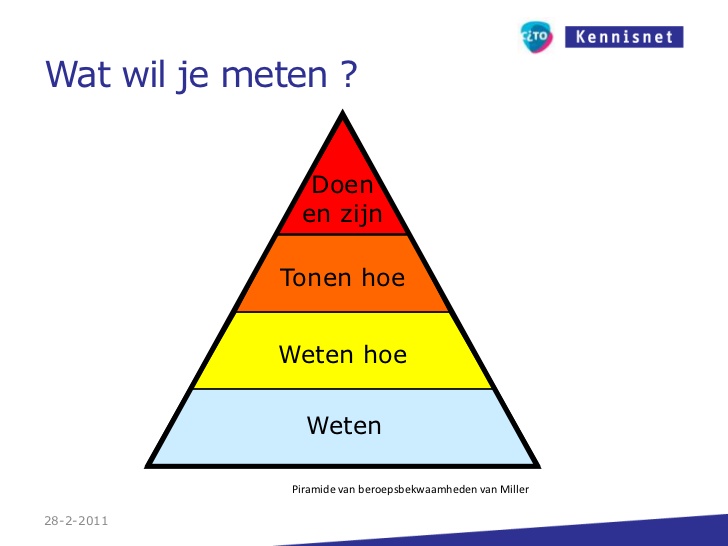
Visie
Miller's pyramid 1. From Academic Medicine 1990;65:S63-7; with permission from Wolters Kluwer Health. The component that Miller argued is the most vital aspect of measurement, what the learner does in clinical practice, has been the most difficult to capture. Almost 2 decades later, we are still struggling with the need to develop reliable.

PPT DE PIRAMIDE VAN MILLER PowerPoint Presentation, free download ID832590
Abstract. The iconic Miller's pyramid, proposed in 1989, characterizes 4 levels of assessment in medical education ("knows," "knows how," "shows how," "does"). The frame work has created a worldwide awareness of the need to have different assessment approaches for different expected outcomes of education and training.

Download scientific diagram Pirámide de miller junto con sus aplicaciones. from publication B
CINCINNATI - A federal grand jury has charged 12 individuals with conspiring in a racketeering enterprise to defraud individuals through their moving companies located throughout the United States, including in Florida, Ohio, Maryland, North Carolina, Illinois, Texas, California, Connecticut, Colorado and Missouri. More than 900 customers have been identified as victims of the scheme thus far.

1. Pirámide de Miller Download Scientific Diagram
Piramide van Miller - uitleg taxonomie van Bloom - uitleg piramide van Miller - overlappingen van de 2 denkwijzen - testen van kennis - hoe kan dit toegepast worden in ons vak? De eerste drie niveaus worden ook wel lage denkvaardigheden genoemd. De moeilijkste drie niveaus heten hoge denkvaardigheden. Taxonomie van Bloom vs. piramide van Miller

What is Miller’s Pyramid of Competence? Why it is Extended in 2020? by Medical Education
The beginner to competent model is further supported by Miller's pyramid of competence. Schuwirth L.W.T., Van der Vleuten C.P.M. Programmatic assessment: From assessment of learning to assessment for learning. Med Teach. 2011; 33 (6):478-485. doi: 10.3109/0142159X.2011.565828.

Miller’s hierarchy of learning NICHE International
Download scientific diagram | Piramide van Miller (10). from publication: Development and first experiences of a portfolio for undergraduate internships in medical education | In medical education.

What is Miller’s Pyramid of Competence? Why it is Extended in 2020? by Medical Education
known as the 'Miller pyramid', was the basis for an important move away from the traditional Flexnerian medical educa-tion model that was largely dominated by theoretical knowledge-based assessments, towards examinations based on clinical performance. Miller's pyramid model divides the development of clin-

Basisontwerp van toetsing in de gehele cursus Radboud Universiteit
Miller's pyramid. St.Emlyn's Miller's pyramid (1990) is a way of ranking clinical competence both in educational settings and in the workplace. As a framework it distinguishes between knowledge at the lower levels and action in the higher levels.

Miller’s Pyramid of Clinical Competence The iDea Book
In this framework, Miller distinguished between "action" and the lower levels. "Action" focuses on what occurs in practice rather than what happens in an artificial testing situation. Work based methods of assessment target this highest level of the pyramid and collect information about doctors' performance in their normal practice.

Miller’s pyramid of clinical competence. Adapted from Miller [16] Download Scientific Diagram
Miller's pyramid of clinical competence was developed specifically for assessing students in health care settings. It is useful for aligning learning outcomes (or clinical competencies) with what learners should be able to do at any stage of the learning process.

Assessing students
In 1990 psychologist George Miller proposed a framework for assessing clinical competence. At the lowest level of the pyramid is knowledge (knows), followed by competence (knows how), performance (shows how), and action (does). In this framework, Miller distinguished between "action" and the lower levels. "Action" focuses on what occurs in practice rather than what happens in an.

Evaluación auténtica y pirámide de Miller
The iconic Miller's pyramid, proposed in 1989, characterizes 4 levels of assessment in medical education ("knows," "knows how," "shows how," "does"). The frame work has created a worldwide awareness of the need to have different assessment approaches for different expected outcomes of education and.

Driehoek van Miller Managementmodellensite
Het piramidemodel van Miller (1990) beschrijft de ontwikkeling van een student tot en met het niveau van beroepsbekwaam. Het geeft de opbouw van de complexiteit van een competentie weer, oplopend van relatief eenvoudig tot complex (Van Berkel, Bax & Joosten-ten Brinke, 2017).

Pirámide de Miller 17 Download Scientific Diagram
Miller's pyramid has guided assessment since its introduction; it has also been used to assist in the assessment of professionalism.The recent emphasis on professional identity formation has raised questions about the appropriateness of "Does" as the highest level of aspiration.

Een onderwijs avontuur Wat te denken van trapmodellen?
In 1990, George Miller outlined a new model for the assessment of clinical competency. 1 Miller argued that the traditional assessment of medical students relied too much on testing their knowledge, and not enough on assessing how they would behave in a real-life consultation. 1 His model, known as the 'Miller pyramid', was the basis for an impo.

Miller’s Pyramid Education Theory Made Practical, Volume 4
This article presents lessons learnt from experiences with assessment of professional competence. Based on Miller's pyramid, a distinction is made between established assessment technology for assessing 'knows', 'knowing how' and 'showing how' and more recent developments in the assessment of (clinical) performance at the 'does' level.
